The Tyneside Tramways and Tramroads Company
History
The Tyneside Tramways and Tramroads Company commenced services on its newly built, standard-gauge, overhead electric tramway on the 4th September 1902, initially between Wallsend and North Shields. The system was essentially a single long line with a short branch, totalling 10.99 miles, and was complete by the 18th June 1904. Although extensions were planned, none were ever built.
From the eastern terminus in Prudhoe Street in North Shields, the main line ran southwestwards, mirroring the course of the Tyne, to Willington Quay, where it turned inland towards Wallsend; here a branch ran southwards via Park Road to Neptune Bank, the main line continuing along the High Street before striking off northwestwards — shortly before Shields Road — over a long reserved sleeper formation to Gosforth (Henry Street), where it turned northwards along the Great North Road to a terminus outside Gosforth Park Gates. Although the tracks of the TT&TCo met those of the Tynemouth and District Electric Traction Company in North Shields, the latter tramway was built to a gauge of 3ft 6ins, so no inter-running ever took place; the systems did, however, share a single rail (of dual-gauge track) for a short distance, a situation that was probably unique amongst tramways in the United Kingdom. The western end of the TT&TCo's system was a different matter altogether, its tracks meeting those of Newcastle Corporation Tramways, also standard gauge, at three locations: Neptune Bank, Shields Road and Gosforth (Henry Street). Whilst the NCT at first resisted through running, it eventually relented, NCT cars subsequently working through to both Wallsend and Gosforth Park Gates, and TT&TCo cars working through Newcastle to Stanhope Street.
The tramway served an area densely populated with shipyards, as well as collieries, so was heavily dependent on these industries; as a consequence, it was disproportionately impacted by downturns or strikes within them. However, it also served Gosforth Park and its race track, so was heavily used by racegoers and weekend excursionists. Little is known of the financial affairs of the tramway, though it was presumably profitable until the 1920s, when the economic situation within the area took a dramatic turn for the worse.
The Great War brought huge pressures to the TT&TCo, with greatly increased loadings due to war work, compounded by significant issues stemming from reduced maintenance, government restrictions on renewals (track and tramcars), as well as shortages of staff (both tramcar crews and skilled workers). Like most systems, it probably emerged from the conflict with a significant backlog of repairs and renewals, which despite the high inflation of the post-war period, it appears to have either made good or at least remediated to some extent.
The Northeast was particularly badly affected by the economic downturn of the 1920s, which unfortunately for the company, coincided with the need for major, and therefore expensive track renewals. The company tried to sell out to Newcastle Corporation, and although the latter's Tramway Committee were very receptive, the council was not, so the company had little choice but to close the system. The last TT&TCo tram ran on the 6th April 1930, the company replacing some, though not all of its services, with newly purchased buses. The company had in fact held powers to operate buses (on specific routes) since the 2nd July 1920, but there is no evidence that they ever did so, the first buses arriving to replace the tram services.
This was not, however, the last tram service over TT&TCo tracks, as the NCT purchased the company's Gosforth to Gosforth Park Gates and Neptune Bank to Wallsend lines, and continued to run tram services over them. The last tram over former TT&TCo tracks ran on the Gosforth to Gosforth Park line in April 1948.
Uniforms
Photographs of TT&TCo staff are far from common, and those that have survived, overwhelmingly represent the Edwardian and Great War eras, supplemented by a single photo from the last day of operation.
What has survived, however, clearly shows that motormen and conductors were not initially issued with uniforms, instead wearing smart but informal attire, along with flat caps. By around 1904, however, they were wearing single-breasted jackets with four buttons and lapels; it is difficult to say with absolute certainty, but it would appear that the jackets were unadorned by either badges or marked buttons, everything being plain. The caps were in a drooping-peak style, and initially appear to have carried on oval cloth cap badge, which by 1905 had been replaced by a prominent metal cap badge (still oval), bearing the full company title around the outside, and an employee number — in the open centre — on two narrow bars (see below). The plain jackets were superseded around 1905 by a more traditional single-breasted jacket with five buttons (bearing an elaborate monogram of the company initials — see link), two breast pockets (with button closures), epaulettes and stand-up collars; the latter bore an employee number on the bearer's left-hand side — in individual numerals — and system initials — 'T T & T Co' — on the right-hand side. The uniform buttons, and probably the collar insignia too, were brass.
A photo taken on the last day of operation — 6th April 1930 — strongly suggests that motormen's uniforms (at least) remained unaltered right through to closure, including the drooping-peak caps; the latter could legitimately have been considered to have been fairly old fashioned as early as the Great War, so their retention until the 1930s, probably makes the TT&TCo unique (amongst UK tramway systems) in this regard.
Inspectors wore single-breasted jackets edged in a finer material than the main body, with hidden buttons (or more likely a hook and eye affair) two slit breast pockets and stand-up collars; the latter almost certainly carried the designation 'Inspector' in embroidered script lettering, though this cannot be made out with certainty on surviving photographs. The caps appear to have been in a drooping-peak style, and carried a prominent badge; whether this was identical to those worn by tramcar staff is, however, unclear.
In common with many tramway systems, ladies were employed in significant numbers during the Great War to replace male staff lost to the armed services. Their uniforms comprised long skirts and jackets, the latter being a tailored single-breasted design with five buttons, two breast and two hip pockets (with button fastenings), epaulettes, and high fold-over collars; the latter bore the same badges as those on the men's jackets. Headgear came in two forms, a wide-brimmed, dark-coloured straw bonnet (presumably for summer wear), and a baggy peaked cap, usually referred to as a motor cap (presumably for winter wear); both types of hat bore the standard ‘TT&TCo’ cap badge. The conductresses were also issued with long double-breasted greatcoats bearing six pairs of buttons and epaulettes; these appear to have been devoid of insignia.
A single surviving photograph (see below) shows a lady wearing a completely different style of uniform jacket; this individual may well have been an inspectress, though this is far from clear. She is wearing a long skirt and gaiters, along with a single-breasted jacket bearing five buttons, a waist belt, two hip pockets (with button fastenings), epaulettes, and lapels. The jacket appears to have been devoid of insignia. Her hat is the same type of wide-brimmed, dark-coloured straw bonnet worn by the conductresses, bearing the standard cap badge.
Further reading
For a history of the system, see: 'The Tramways of Northumberland' by George S Hearse; self-published (1961).
Images
Motormen and conductor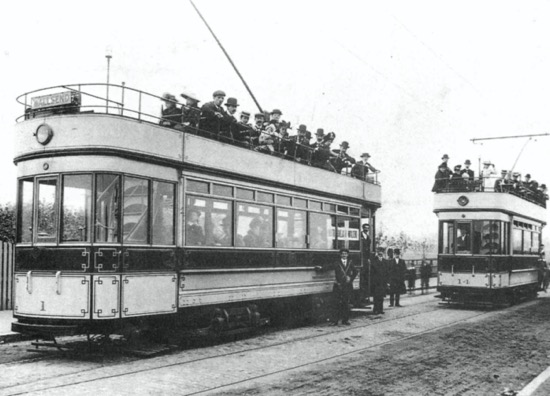
Tramcars No 1 and No 14, both very new-looking, stand in Howdon Road, North Shields — although undated, the photo is thought to have been taken on the opening day (4th September 1902). Photo courtesy of the Malcolm Fraser Collection.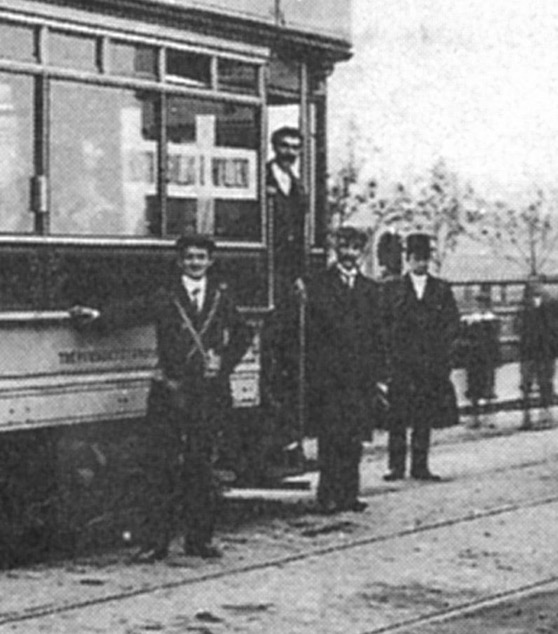
An enlargement of the above photograph, which shows that the conductor is wearing informal attire, including a flat cap.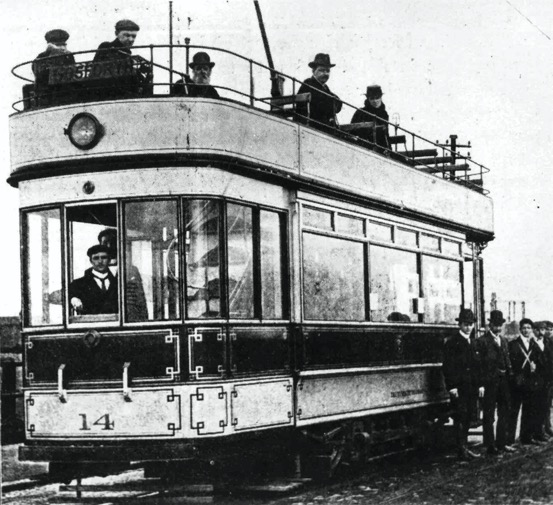
Another early photograph, once again including Tramcar No 14, but this time with a Gosforth destination indicator, so probably taken on a shortly after the 18th October 1902, when the line to Gosforth was opened. Both the motorman (seen through the front window) and the conductor (with cash-bag straps; at the right) are wearing informal attire, including flat caps. Photo courtesy of the Malcolm Fraser Collection.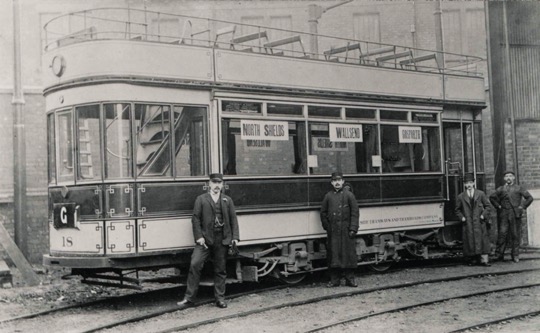
A pristine-looking Tramcar No 18 stands in the depot yard at Neptune Bank, Wallsend — photo undated, but given the condition of the vehicle, and the fact that it carries paper destination stickers advertising Gosforth, probably taken around the time that route was opened (18th October 1902). Photo courtesy of the Malcolm Fraser Collection.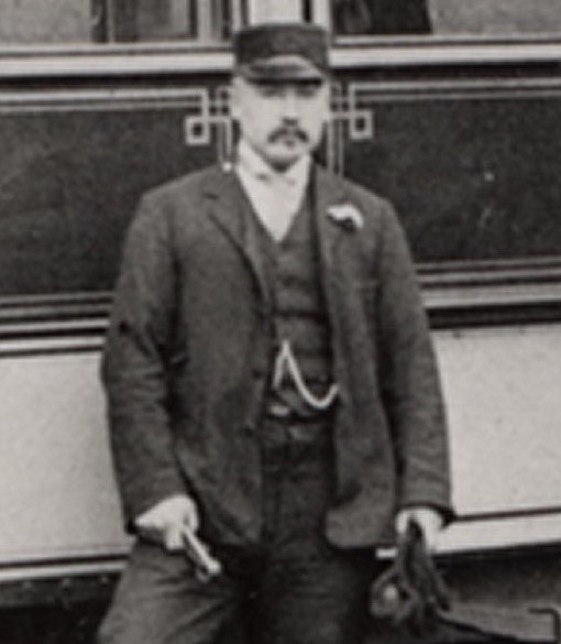
An enlargement of the above photograph showing the motorman, with controller in hand. He is clearly wearing informal attire, but with what is almost certainly a company-issued, drooping-peak cap bearing an oval cap badge; as the badge is unreflective, it is likely to have been of embroidered cloth.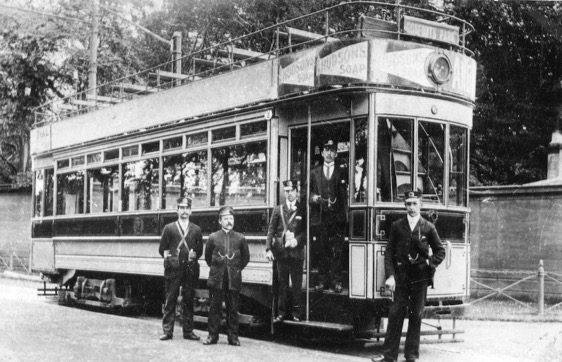
TT&TCo Tramcar No 1, now carrying adverts, stands outside Gosforth Park gates — photo undated, but probably taken around 1904/5. Left to right: a conductor, an inspector, a conductor, and two motormen. Author's Collection.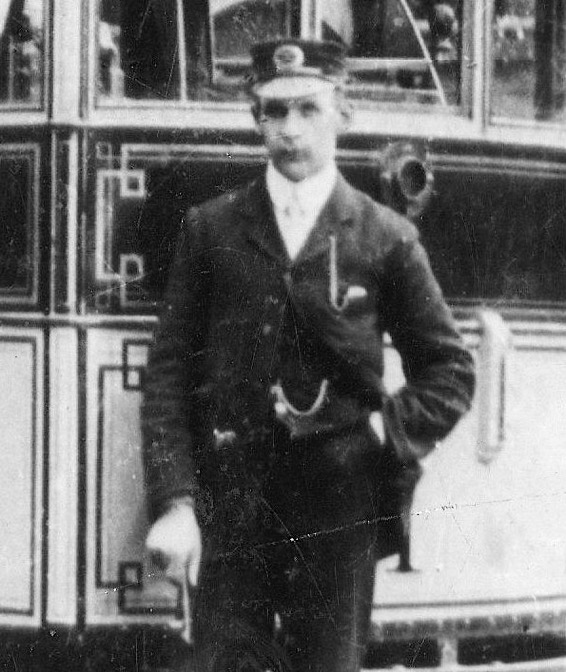
An enlargement of the above photograph, showing one of the motormen. Whilst his jacket appears to be devoid of insignia, the large oval cap badge on his drooping-peak cap is easily made out.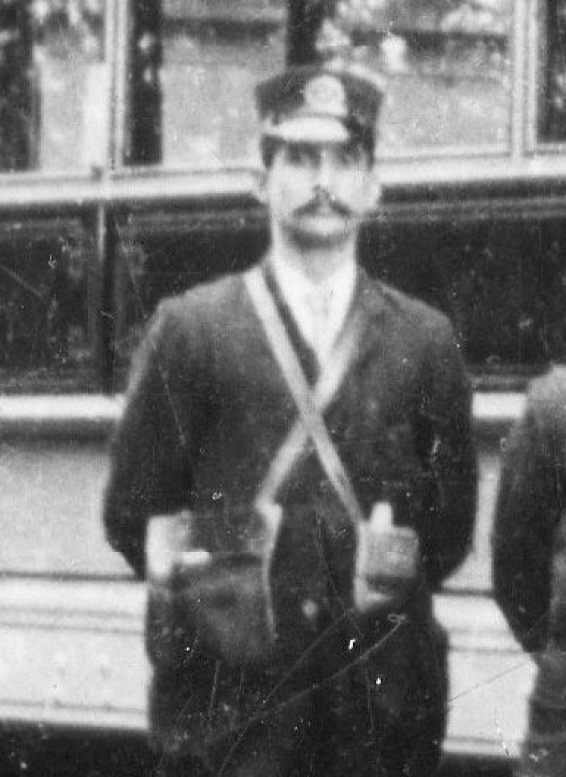
Another blow-up of the above photograph, this time showing one of the conductors. His uniform jacket again appears to bear no insignia.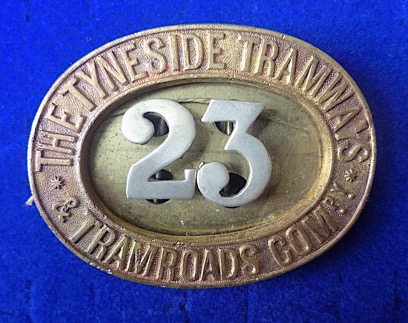
TT&TCo cap badge No 23 with back plate — gilt/brass with nickel numbers — worn from around 1904 to 1930. Author's Collection.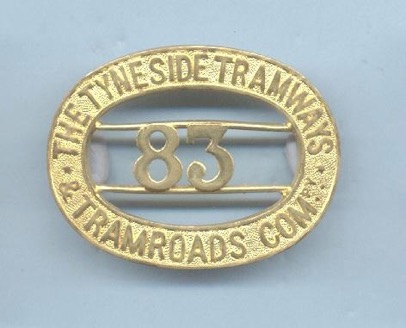
TT&TCo cap badge No 83 with brass numbers soldered onto wire — gilt/brass. Photo courtesy of the Stephen Howarth Collection.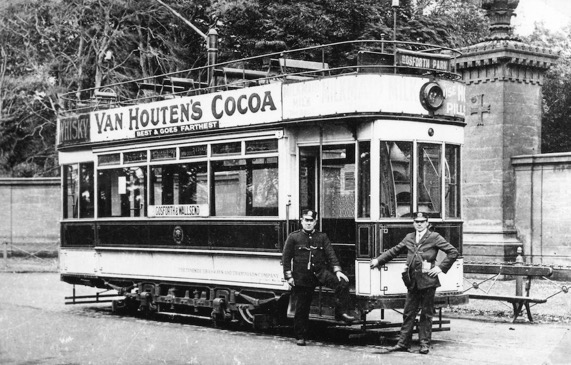
Another fairly new TT&TCo Tramcar outside Gosforth Park gates, this time No 16 — photo taken in 1905. Author's Collection.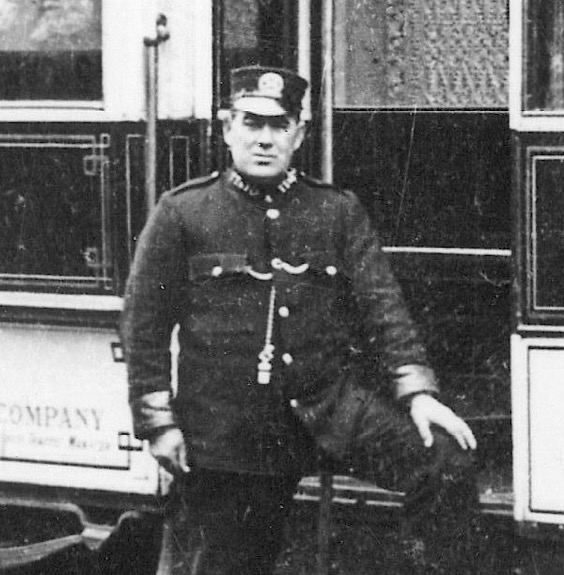
An enlargement of the above photograph showing Motorman A. Mole. A switch had evidently be made to single-breasted tunics by this time, at least for motormen. The collars carry an employee number on one side and 'T T & T Co' initials on the other.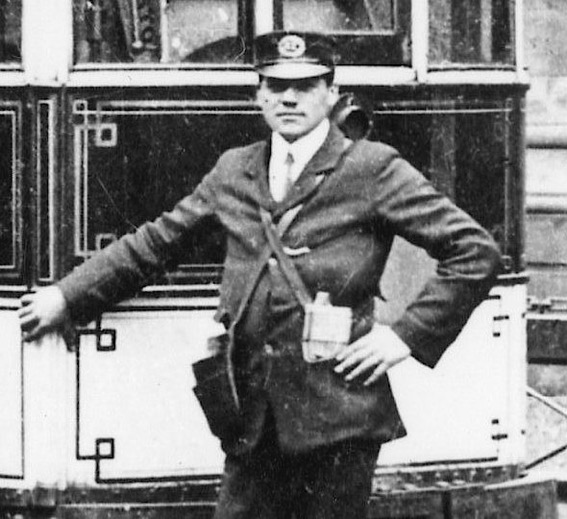
Another blow-up of the above photograph, this time showing the conductor, who is still wearing a jacket devoid of insignia.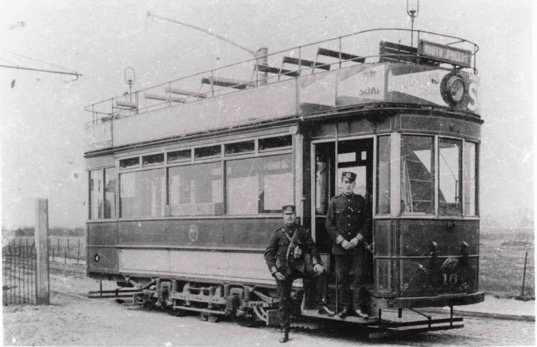
The crew of Tramcar No 16 stand at what would appear to be the start of the reserved track section in Wallsend — photo undated, but probably taken around 1910. Photo courtesy of the Malcolm Fraser Collection.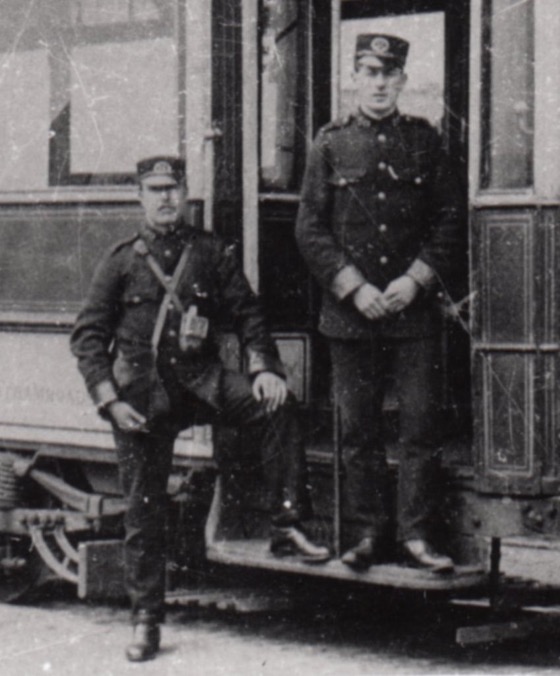
An enlargement of the above photograph showing the conductor and motorman, both men wearing single-breasted jackets with stand-up collars and epaulettes.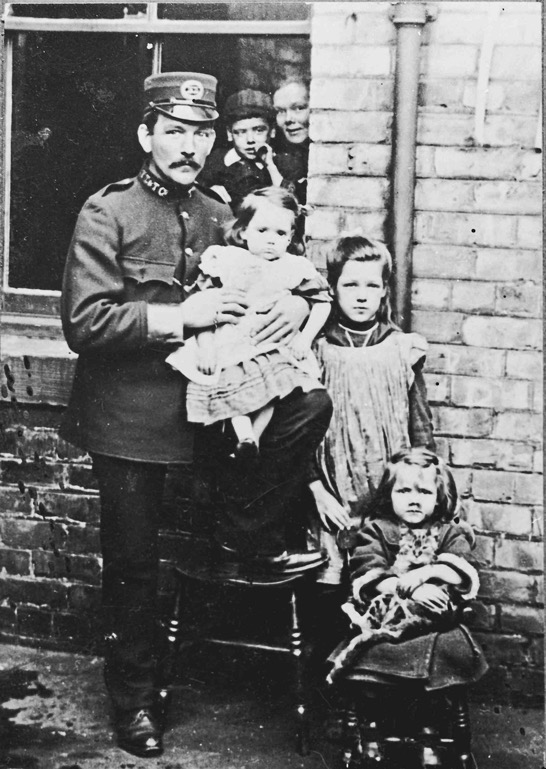
A TT&TCo motorman posing with his family in Wallsend in 1912. Image kindly supplied by Beamish Museum Limited (see link), image copyright Beamish Museum Limited.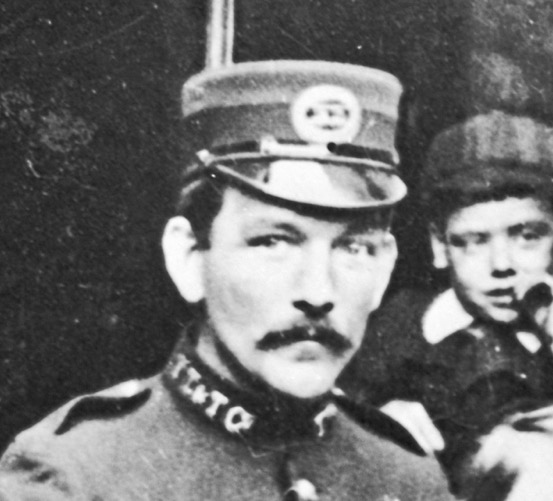
An enlargement of the above photograph showing details of the uniform insignia.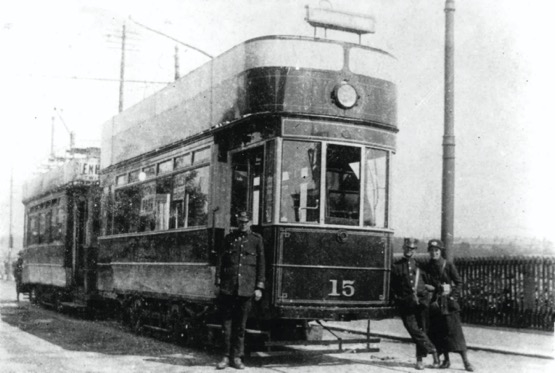
Two trams, including No 15, stand at an unidentified location — photo undated, but certainly taken during or shortly after the Great War. Both the men are wearing drooping-peak caps. Photo courtesy of the Malcolm Fraser Collection.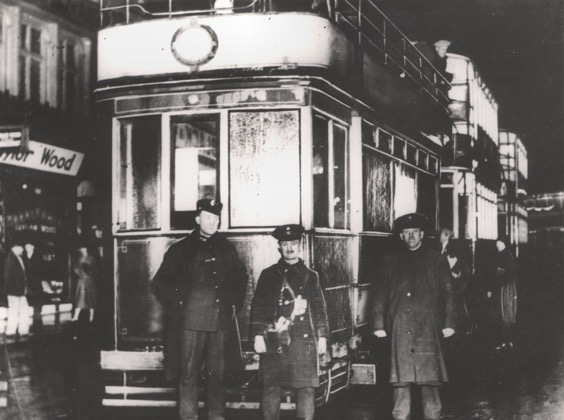
A photograph taken in New Bridge Street on the 6th April 1930, the last day of operation, showing TT&TCo motorman A Tierney (left). Although at first glance this image would appear to suggest that motormen and conductors wore different uniforms, the trams are actually from three different systems: TT&TCo, Gateshead & District Tramways, and Newcastle Corporation Tramways, the figures on the right being corporation employees. Somewhat surprisingly, Motorman Tierney appears to be wearing a drooping-peak cap, which by this time must have seemed incredibly old fashioned.
Senior staff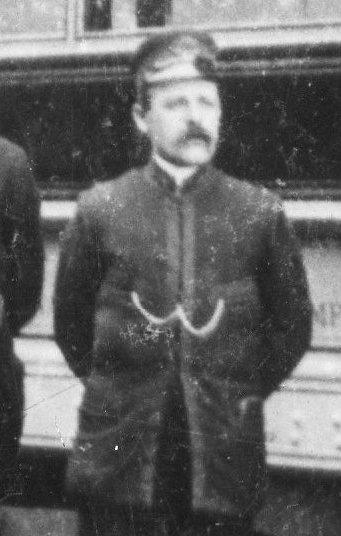
An enlargement of the photograph of Tramcar No 1 above, showing one of the inspectors.
Female staff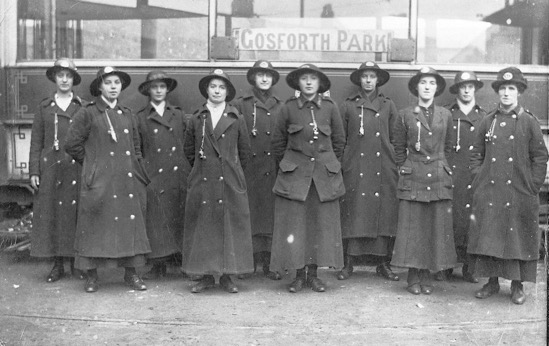
A group of TT&TCo conductresses at Wallsend Depot in 1917. Image kindly supplied by Beamish Museum Limited (see link), image copyright Beamish Museum Limited. 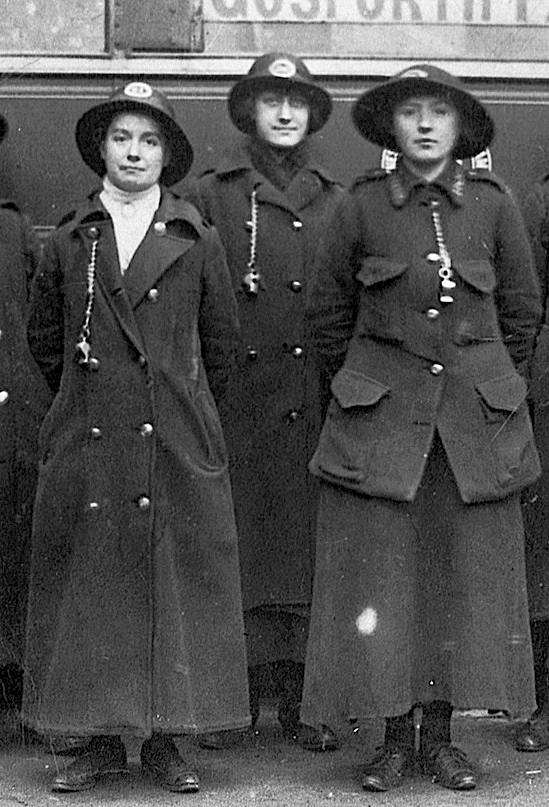
An enlargement of the above photograph showing three of the conductresses. The lady on the right is wearing a single-breasted jacket with high, fold-over collars and epaulettes. 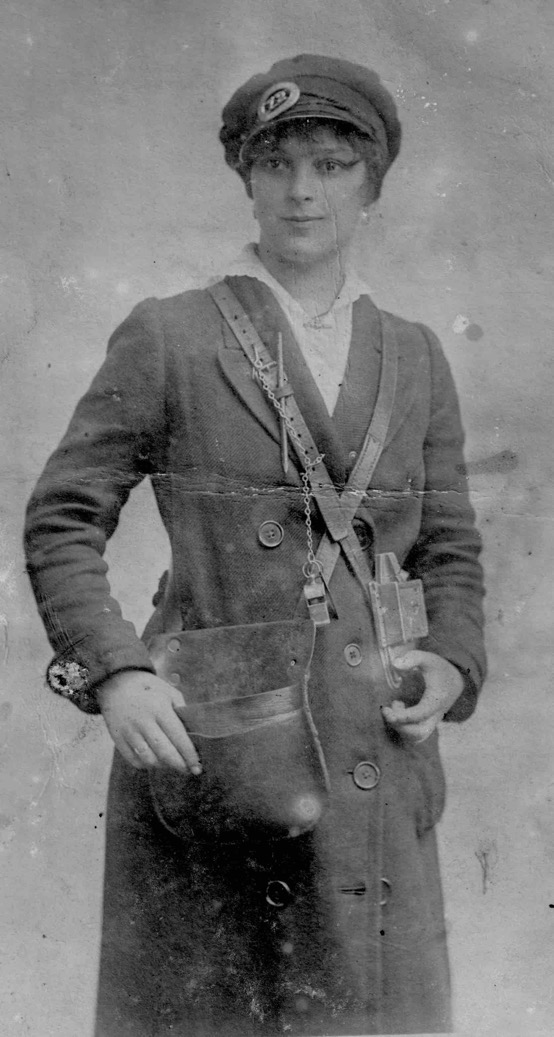
A rare studio portrait of a Great War TT&TCo tram conductress. She appears to be wearing her own top coat, along with a company-issued motor cap bearing the standard cap badge. Author's Collection.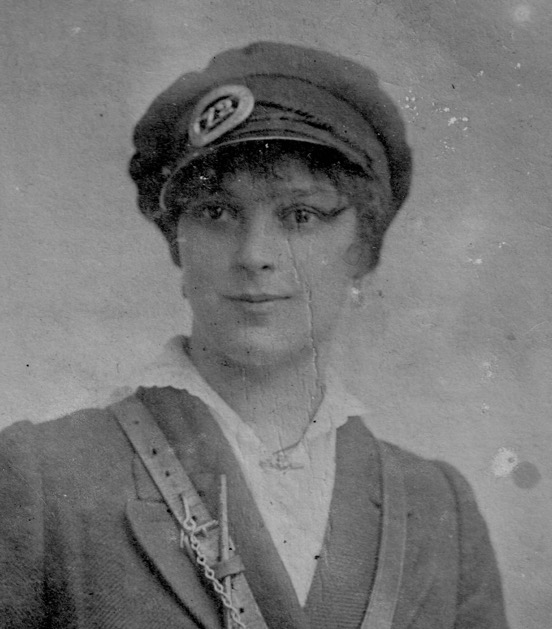
An enlargement of the above photograph, which reveals the subject to have been Employee No 72.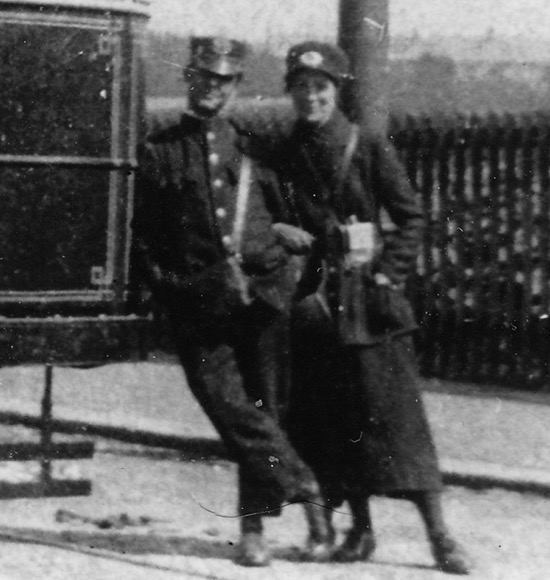
An enlargement of the Great War photograph of Tramcar No 15 above, showing a conductor and a conductress; she is wearing a motor cap, with the usual cap badge.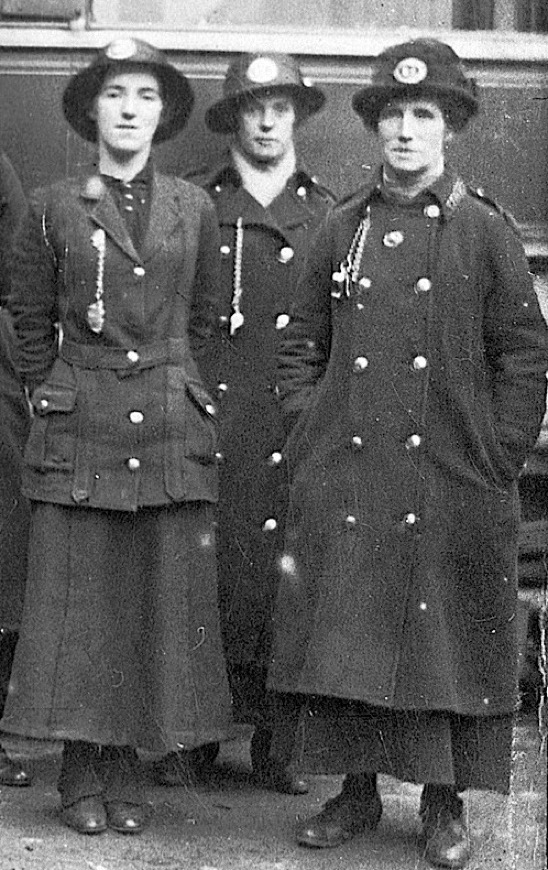
An enlargement of the Great War conductresses photograph above showing a lady, on the left, who is wearing a different style of jacket. It is possible, though far from certain, that she is an inspectress.